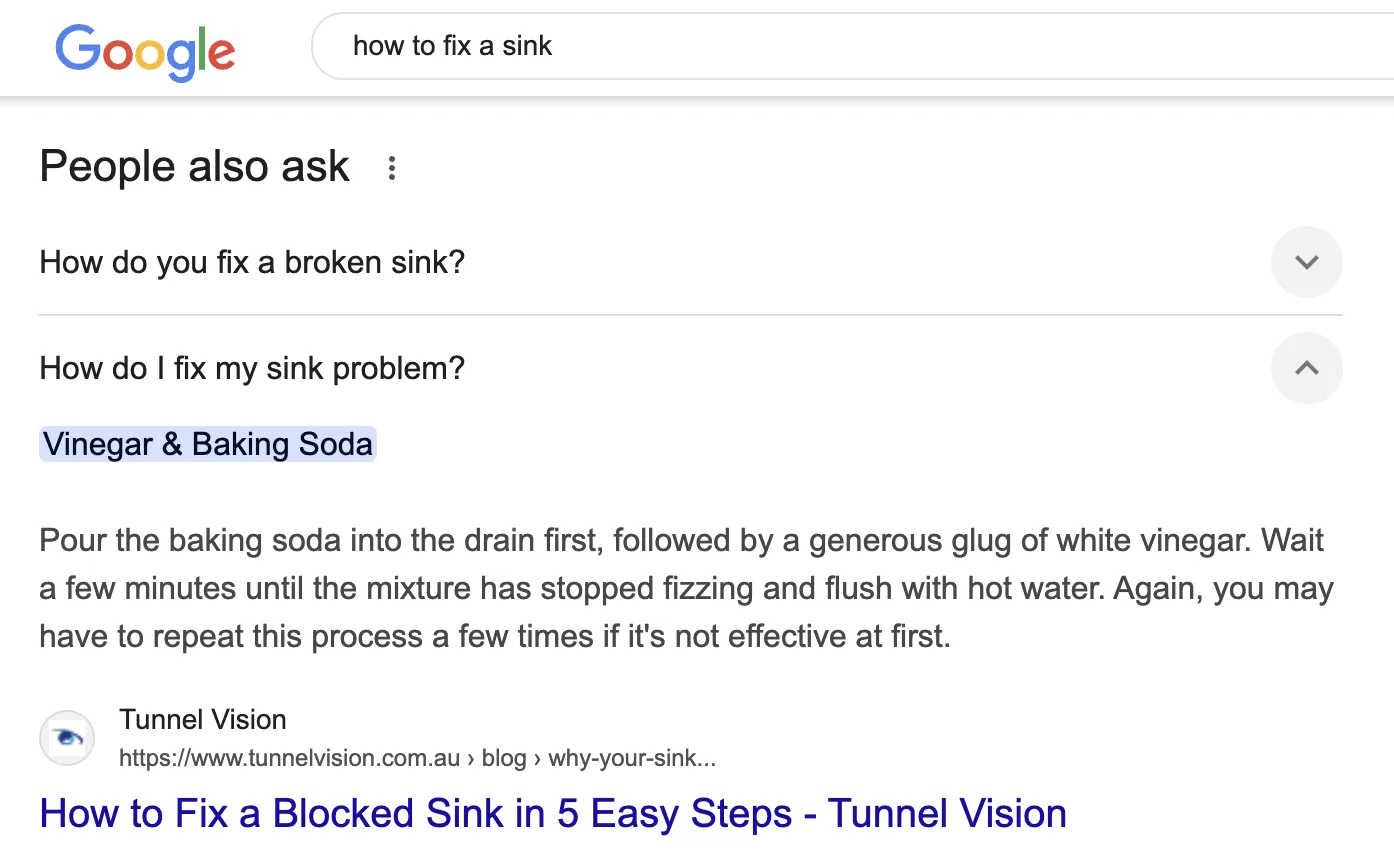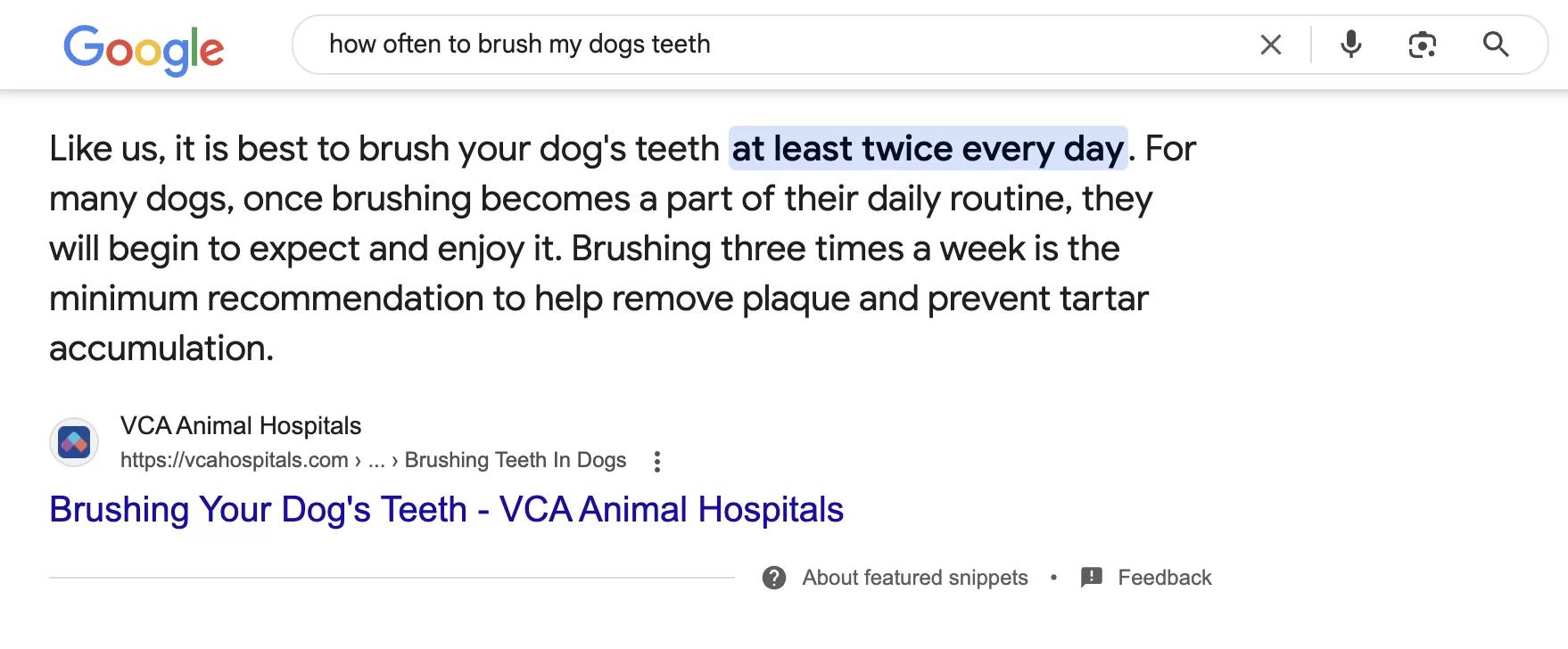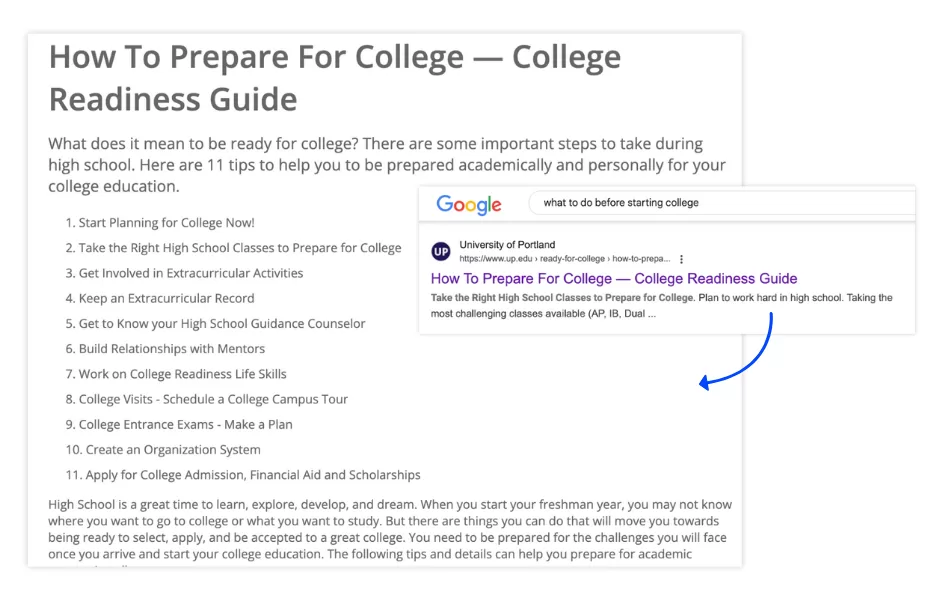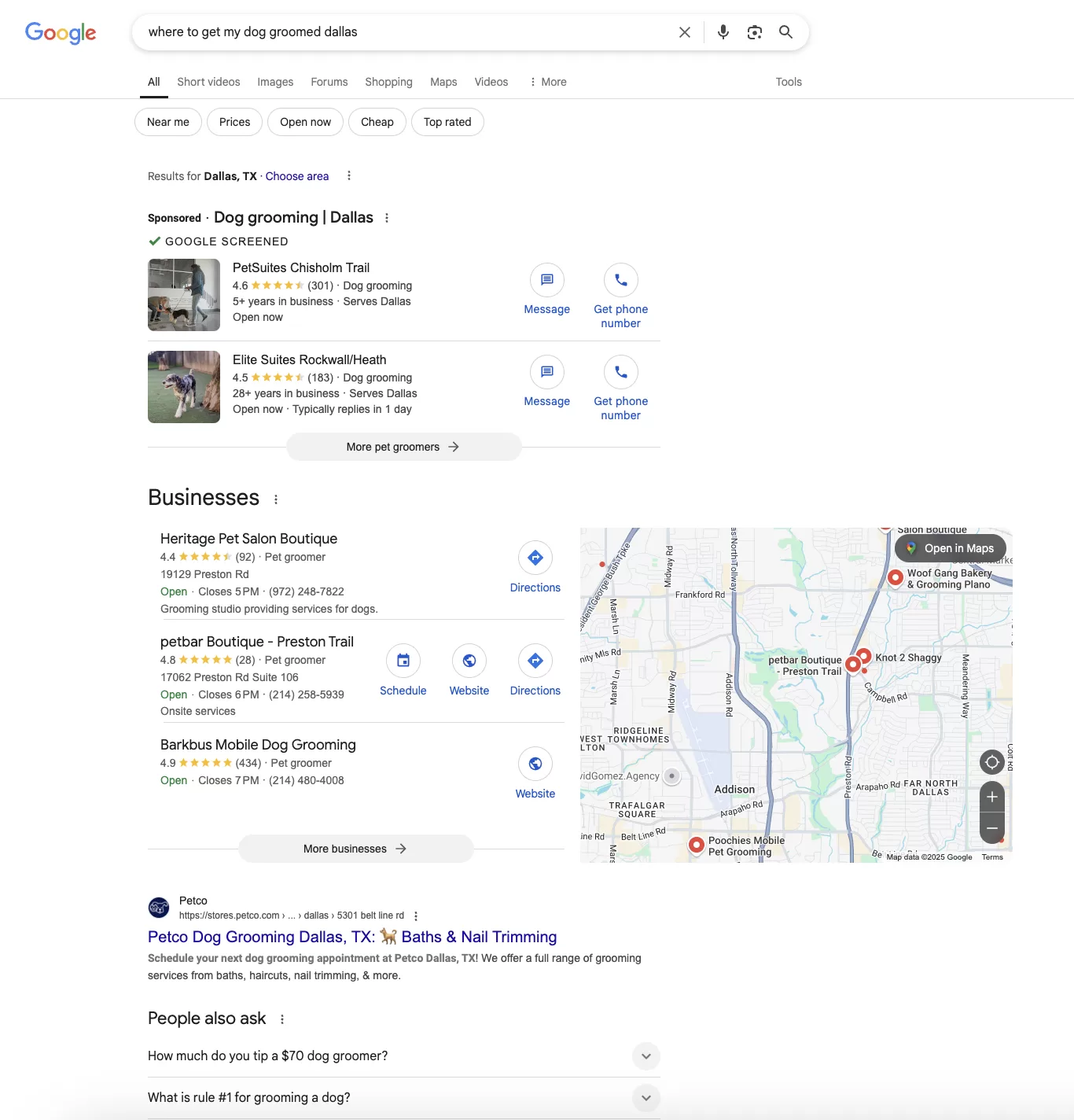More searches than ever are ending without a click. Instead of directing users to websites, Google is delivering answers directly on the results page through featured snippets, knowledge panels, and other SERP features.
In 2024, about 65% of global Google searches didn’t result in a click, and on mobile, that number was even higher (over 75%). With AI-powered search evolving fast, this trend is expected to grow even more in 2025.
So, what does this mean for businesses? While fewer clicks can mean less traffic, visibility is now just as valuable. If you can secure a spot in these high-visibility SERP features, you can still stay in front of your audience and build brand authority.
Here’s how to make zero-click searches work for you.
Contents
- What are zero-click searches?
- SEO in the age of zero-click searches: How it impacts businesses
- Strategies to thrive in a zero-click world
- How to measure success in a zero-click environment
What are zero-click searches?
Zero-click searches happen when users get their answers directly from Google’s search results page without the need to visit any specific website. These answers come in the form of:
- Featured Snippets: Quick, direct answers pulled from web pages.
- Knowledge Panels: Information from authoritative sources like Wikipedia, government domains, and more.
- People Also Ask (PAA) boxes: Related questions and answers.
- Google Business Profiles: Essential details for local businesses, like hours and contact info.
- AI Overviews: AI-generated responses compiled from content across the web.
Even though these are great solutions for users, it’s less thrilling for businesses, for a simple reason: When Google provides the answer upfront, fewer people will visit websites.
Some industries are feeling the shift more than others. Local businesses benefit from Google Business Profiles, while news sites lose traffic as Google pulls headlines into search results. Ecommerce brands compete with AI-generated product summaries, and B2B/SaaS companies struggle to drive clicks from informational searches. Even health and finance sites see Google favor big-name sources over independent ones.
With AI-driven search (SGE) expanding, it’s safe to claim that zero-click searches are here to stay. Featured snippets are getting smarter, PAA boxes are growing, and local search features are becoming stronger than ever, all designed to keep users on Google longer.
But zero-click doesn’t have to mean zero opportunity.
 Free guide >> 10 Tangible & Free Ways to Get on the First Page of Google
Free guide >> 10 Tangible & Free Ways to Get on the First Page of Google
SEO in the age of zero-click searches: How it impacts businesses
For years, SEO was all about ranking high and getting clicks, but now, even those ranking #1 for relevant keywords are no longer guaranteed engagement. Businesses that rely on organic search to drive leads, sales, or ad revenue are seeing fewer clicks, forcing a major shift in strategy.
“Ignoring zero-click searches means risking visibility. If competitors secure featured snippets, knowledge panels, or PAA spots, they become the go-to source while your brand fades into the background. This is especially critical in competitive industries where brand awareness is just as important as website visits,” said Stephanie Yoder, Director of Content at Rebrandly.

At the same time, this shift presents an opportunity to rethink content strategy. “Market shifts like this always come with pros and cons, but one potential upside is a renewed focus on quality, value, and accessibility,” said Nikiya Griffith, Head of Content Marketing at TeamOhana. “With declining click-through rates, brands need to make sure their websites meet accessibility standards, are optimized for screen readers, and deliver a seamless user experience for the visitors they do get.”
Diversification is also key. “You’re more likely to appear in featured snippets and rich results if you go beyond traditional articles. High-quality videos and other engaging formats can help ensure your content reaches its audience in new ways,” Griffith adds.

Videos for the same query example show above many results and the PAA on the SERP.
 Looking for more ways to drive people to your site? Free guide >> 25 Ways to Increase Traffic to Your Website
Looking for more ways to drive people to your site? Free guide >> 25 Ways to Increase Traffic to Your Website
4 proven strategies to thrive in a zero-click world
So how can you continue seeing success despite zero-click searches? Here are some strategies to try.
1. Optimize for featured snippets and knowledge panels
Google favors clear, structured content that directly answers user queries, so optimizing for these features is all about making your information easy to extract and display.
Featured snippets often take the form of paragraphs, lists, tables, steps, definitions, and comparisons, depending on the type of query.
- Paragraph snippets work best for definitions and direct answers. Aim for 40-60 words, as Backlinko’s research suggests this is the optimal length for snippet selection.
- List snippets (bulleted or numbered) are ideal for step-by-step guides, ranking-based content, or “best of” lists.
- Table snippets help organize data for easy comparison, making them great for pricing, feature breakdowns, and statistical content.
- Comparison snippets perform well when contrasting two or more products, services, or concepts in a structured way.

By structuring your content with these formats in mind (and placing the most relevant information early in a section), you increase the likelihood of being featured in search results and capturing valuable visibility.
2. Focus on good content structuring and sound technical SEO techniques
By combining structured content with strong technical SEO, you can increase your likelihood of being featured in zero-click searches and staying visible. Here are some tips to keep in mind.
- Create question-based content: Google often pulls snippet content from answers to common user questions. Structuring content around “what,” “how,” and “why” questions improves your chances of ranking in these prime SERP spots.
- Implement structured data: Implementing structured data with schema markup (such as FAQ, HowTo, and Article schema) helps Google better understand and categorize your content, increasing the chances of appearing in SERP features like rich snippets, knowledge panels, and carousels.
- Format for maximum visibility: Clear headings, bullet points, tables, and concise paragraphs make it easier for Google to extract information for featured snippets. A direct, well-structured answer at the start of a section improves your chances of ranking.

- Optimize for mobile: Since most zero-click searches happen on mobile, ensuring fast load times, responsive design, and easy navigation improves search performance.
- Prioritize page speed and user experience: A slow site can hurt rankings and visibility. Optimizing images, reducing unnecessary scripts, and improving Core Web Vitals ensure your content is more likely to appear in high-ranking search features.
3. Leverage PPC
If Google’s keeping more traffic for itself, businesses may have to pay to play. While zero-click searches make it harder to drive organic traffic, PPC ads can help you stay visible and capture those lost opportunities. Whether you’re promoting content or bidding on high-intent keywords, smart ad strategies can keep your business front and center.

Google Local Services Ads appear at the top of the page–above Google Business listings, an organic listing, and the PAA section of the SERP for this query.
- Strategically select keywords: Focus on keywords that still drive clicks. Informational queries might be tough, but commercial and transactional searches are where you can win. Test targeting long-tail keywords that show clear buying intent.
- Optimize ad placement: Don’t just aim for the top spot. Try to experiment with different placements, like shopping ads, video ads, and even discovery ads to reach your audience where they’re most engaged.
- Follow budget allocation best practices: Balance your spending between branded and non-branded keywords, and use remarketing to stay in front of users who interacted with your content but didn’t convert right away.
 Want to learn more about search engine marketing on Google? Get the free guide >> PPC 101: Complete Guide to Google Ads
Want to learn more about search engine marketing on Google? Get the free guide >> PPC 101: Complete Guide to Google Ads
4. Diversify traffic sources
“If Google is sending you less traffic, it’s time to stop relying on one source and build a more resilient strategy. Expanding your reach through other channels helps reduce dependency on organic search,” said Vova Feldman, CEO of Freemius.
To future-proof your traffic and stay in control of your audience, consider these approaches:
- Experiment with social media strategies: Platforms like LinkedIn, X, and YouTube aren’t just for engagement; they can be powerful search engines in their own right. Repurpose blog content into bite-sized, shareable posts to drive awareness and clicks.
- Make email marketing a priority: Don’t wait for people to find you. Bring your content straight to them. Regular newsletters, exclusive insights, and personalized recommendations keep your audience engaged without depending on search traffic.

- Expand content distribution: Explore syndication, guest posting, and partnerships to get your content in front of new audiences. Platforms like Reddit and niche forums can drive highly targeted traffic outside of Google’s grip.
At the end of the day, Google doesn’t own your audience—you do. By leveraging PPC and diversifying traffic sources, you can stay visible, build brand equity, and keep driving results, regardless of where search trends go.
How to measure success in a zero-click environment
With fewer clicks to track, traditional SEO metrics no longer tell the full story. But that doesn’t mean you’re flying blind. You just need to rethink how to measure success. Instead of focusing purely on traffic, focus on brand visibility, engagement, and impact.
But how do you measure success when the old metrics don’t tell the full story? Let’s break it down step by step.
Key performance indicators
Here are the metrics that are important to keep track of.
Brand visibility metrics
Even if people aren’t clicking, they still see your brand in search. Here’s how you can measure that exposure:
- Track your impressions in Google Search Console
- Go to Search Console → Performance → Search Results
- Look at “Total Impressions” and “Average Position”
- Filter for your brand name to see how often people search for you specifically.
- Monitor your presence in SERP features
- Use a tool like Ahrefs or Semrush to track if you’re appearing in:
- Featured snippets
- Knowledge panels
- People Also Ask (PAA) boxes
- AI Overviews
- If you’re ranking for a featured snippet but not getting clicks, the snippet from your content might be answering the question fully, which still builds brand awareness.
- Use a tool like Ahrefs or Semrush to track if you’re appearing in:

This site can see that its showing in the AI Overview for this keyword.
Alternative success measurements
Beyond clicks, here’s how to measure whether your search visibility is actually making an impact:
- Check if direct traffic is increasing
- In GA4, go to Reports → Acquisition → Traffic Acquisition
- Look at Direct traffic—this includes visitors who typed your URL or clicked a saved bookmark.
- If Direct traffic rises while Organic Search stays flat, people may have seen you in search and visited later.
- Look for traffic spikes from search features
- In GA4, go to Reports → Acquisition → Referral Traffic
- Look for sudden spikes from Google Search; these often correlate with featured snippets or knowledge panels.
Return on investment
To connect your search visibility efforts to real business outcomes, track:
- How many conversions start with search
- In GA4, go to Reports → Advertising → Attribution → Conversion Paths
- Filter by “Organic Search” to see assisted conversions (cases where search played a role, even if it wasn’t the last-click source).
- If search appears early in the conversion journey, it’s driving awareness—even if clicks aren’t immediate.
- The impact of brand searches on conversions
- In GA4, go to Reports → Acquisition → Traffic Acquisition
- Compare Direct traffic conversions vs. Organic Search conversions.
- If Direct conversions increase after an SEO push, it suggests search helped plant the seed, and users came back later to convert.
Analytics and tracking
Now that you know what to track, let’s talk about how to track it.
Set up custom reporting
Setting up reports that focus on visibility, engagement, and business impact instead of just traffic will give you a clearer picture of success:
- Google Search Console Dashboard (Looker Studio)
- Open Looker Studio (formerly Data Studio)
- Connect Google Search Console
- Add Impressions, Clicks, and Average Position to track visibility over time.
- Custom GA4 Reports for Zero-Click Tracking
- Track Direct traffic trends to see if search visibility is translating into brand awareness.
- Set up Attribution reports to measure assisted conversions from search visibility.
Use the right tracking tools
Use these tools to track performance in a zero-click environment:
- Google Search Console: Measures impressions and search presence.
- Google Analytics (GA4): Tracks Direct traffic growth, assisted conversions, and referral traffic spikes.
- Ahrefs/Semrush: Monitors SERP features like featured snippets and knowledge panels where your brand appears.
- Brand monitoring tools (e.g., Brandwatch, Mention): Helps track mentions and visibility beyond search clicks.
Look at performance benchmarks
To determine if your zero-click SEO efforts are paying off, compare:
- Before-and-after metrics for SERP visibility: Are impressions increasing even if clicks aren’t?
- Direct traffic growth over time: Is there an uptick in visitors who type your URL after seeing your brand in search?
- Conversion rate changes: Are more users starting their journey through search and converting later via direct visits?
Future-proof your digital strategy by optimizing for zero-click searches
Zero-click searches aren’t going away. They’re becoming the norm. To stay ahead, you need to adapt early and diversify your approach to avoid relying too much on organic clicks.
AI-powered search, voice search, and interactive SERPs are changing how users find information. Optimizing for conversational queries and structured answers will keep you visible in this evolving space.
Instead of just chasing rankings, focus on brand building, thought leadership, and multichannel marketing. Prioritizing owned channels like email, communities, and social media will help you stay resilient, even when search algorithms shift.
The businesses that thrive in a zero-click world don’t just rank—they own the search experience and create a lasting presence.
The post 4 Ways to Optimize for Zero-Click Searches appeared first on WordStream.